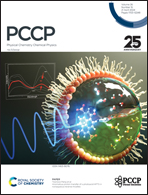Thermodynamic model for voltammetric responses in conducting redox polymers†
Abstract
Electroactive polymer materials are known to play important roles in a vast spectrum of modern applications such as in supercapacitors, fuel cells, batteries, medicine, and smart materials, etc. They are usually divided into two main groups: first, conducting π-conjugated organic polymers, which conduct electricity by cation-radicals delocalized over a polymer chain; second, redox polymers, which conduct electricity via an electron-hopping mechanism. Polymer materials belonging to these two main groups have been thoroughly studied and their thermodynamic and kinetic models have been built. However, in recent decades a lot of mixed-type materials have been discovered and investigated. To the best of our knowledge, a thermodynamic-based description of conducting redox polymers (CRPs) has not been provided yet. In this work, we present a thermodynamic model for voltammetric responses of conducting redox polymers. The derived model allows one to extract thermodynamic parameters of a CRP including the polaron delocalization degree and redox active groups interaction constant. The model was verified with voltammetric experiments on three recently synthesized CRPs and showed a satisfactory predictive ability. The simulated data are in good agreement with the experiment. We believe that developing theoretical descriptions for CRPs and other types of electroactive materials with the ability to simulate their electrochemical responses may help in future realization of new systems with superior characteristics for electrochemical energy storage, chemical sensors, pharmacological applications, etc.



 Please wait while we load your content...
Please wait while we load your content...